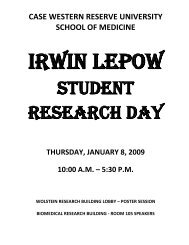Policy for Use of Avian Embryos - Case Western Reserve University ...
Policy for Use of Avian Embryos - Case Western Reserve University ...
Policy for Use of Avian Embryos - Case Western Reserve University ...
Create successful ePaper yourself
Turn your PDF publications into a flip-book with our unique Google optimized e-Paper software.
CWRU IACUC<br />
School <strong>of</strong> Medicine WG-78<br />
IACUC: (216) 368-6979/368-3815<br />
Training: (216) 368-4972<br />
<strong>Avian</strong> <strong>Embryos</strong> <strong>Use</strong><br />
Form Date 07/2008<br />
Date Rec’d<br />
All use <strong>of</strong> vertebrate animals in research, teaching and testing is regulated by the Institutional<br />
Animal Care and <strong>Use</strong> Committee (IACUC). <strong>Avian</strong> embryos are not considered live animals by<br />
U.S. regulatory agencies and many universities do not regulate their use in research.<br />
Nonetheless, there is a consensus in the scientific community that avian embryos greater than<br />
two-thirds <strong>of</strong> the way to hatching can experience pain. If avian embryos hatch, intentionally or<br />
unintentionally, they are live vertebrate animals and are regulated by the IACUC. Consequently,<br />
the CWRU IACUC has developed the following guidelines. Chick embryos are considered the<br />
model species. If other avian species are used, then the guidelines should be adjusted based<br />
on relative time to hatching.<br />
1) Investigators using avian embryos must in<strong>for</strong>m the IACUC by means <strong>of</strong> the “Notice <strong>of</strong><br />
Intent to <strong>Use</strong> <strong>Avian</strong> <strong>Embryos</strong>” <strong>for</strong>m below. This <strong>for</strong>m serves as a record <strong>of</strong> avian embryo<br />
use <strong>for</strong> the IACUC. If embryos will be sacrificed prior to 3 days be<strong>for</strong>e hatching, the<br />
research will not be subject to IACUC review unless specifically requested by the<br />
investigator. Studies using embryos within three days <strong>of</strong> hatching or hatchlings must be<br />
reviewed by the normal IACUC procedure <strong>for</strong> vertebrate animals.<br />
2) Chick embryos younger than embryonic day 15 (E15) are assumed to be unable to<br />
experience pain. It is recommended that E14 or younger embryos be euthanized by<br />
hypothermia, typically by placing the eggs in a −20°C freezer.<br />
3) Chick embryos from E15 to E18 can experience pain and should be euthanized by<br />
decapitation or other rapid and humane method.<br />
4) <strong>Embryos</strong> E19 and older must be euthanized by humane methods such as C02,<br />
anesthetic agents or decapitation. It should be noted that embryos are resistant to C02. If<br />
this method is chosen, the embryos must be exposed to 90% C02 <strong>for</strong> at least 20 min. Dry<br />
ice is unacceptable as a source <strong>of</strong> C02 <strong>for</strong> euthanasia.<br />
5) The IACUC recognizes that inadvertent hatching may occur. Investigators are asked to<br />
describe their methods <strong>for</strong> humane euthanasia <strong>of</strong> hatchlings.<br />
These guidelines were developed based on recommendations <strong>of</strong> ILAR, the NIH intramural<br />
recommendations <strong>for</strong> rodent neonates, and the AVMA Panel on Euthanasia.<br />
Submit the completed <strong>for</strong>m to the CWRU IACUC Office, Room WG-77, School <strong>of</strong><br />
Medicine, Telephone (216) 368-3815, Fax (216) 368-4805.<br />
1
CWRU IACUC<br />
School <strong>of</strong> Medicine WG-78<br />
IACUC: (216) 368-6979/368-3815<br />
Training: (216) 368-4972<br />
I. Contact In<strong>for</strong>mation<br />
Principal Investigator:<br />
Department:<br />
Institution:<br />
<strong>Avian</strong> Embryo <strong>Use</strong><br />
Building: Room: Location code:<br />
E-mail:<br />
Phone: Fax: Pager:<br />
II. <strong>Avian</strong> Embryo <strong>Use</strong> Summary<br />
1) <strong>Avian</strong> Species:<br />
2) Age(s) <strong>of</strong> <strong>Embryos</strong>:<br />
3) Method <strong>of</strong> euthanasia <strong>of</strong> chick embryos older than E14:<br />
4) Age at which unused embryos will be discarded:<br />
5) Procedures <strong>for</strong> humane euthanasia should hatching occur inadvertently:<br />
6) Building and room number where avian embryo use will occur:<br />
III. Investigator Assurances<br />
I have read the CWRU IACUC "<strong>Policy</strong> <strong>for</strong> <strong>Use</strong> <strong>of</strong> <strong>Avian</strong> <strong>Embryos</strong>" and agree to abide by it.<br />
Signature Date<br />
2
















